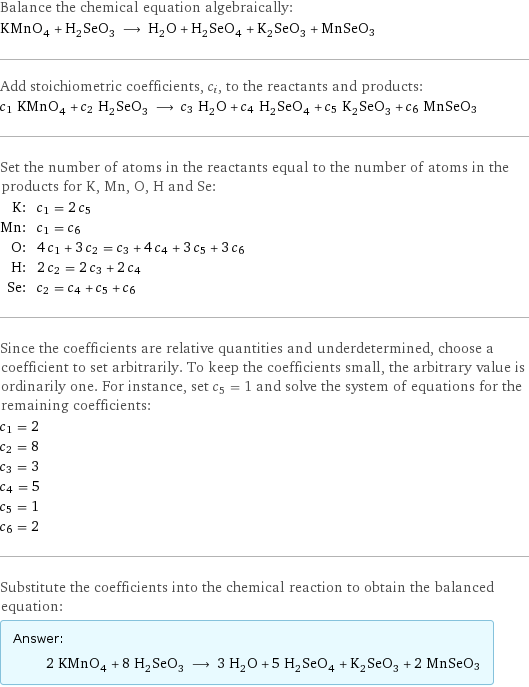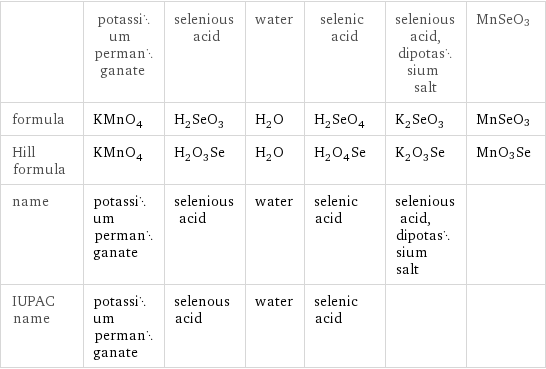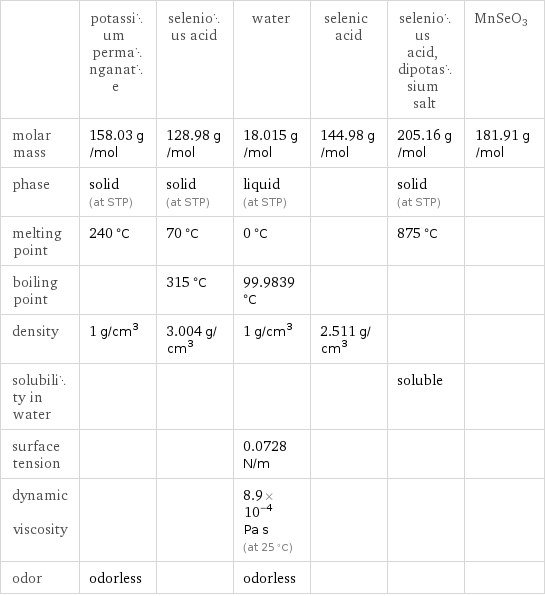Input interpretation

KMnO_4 (potassium permanganate) + H_2SeO_3 (selenious acid) ⟶ H_2O (water) + H_2SeO_4 (selenic acid) + K_2SeO_3 (selenious acid, dipotassium salt) + MnSeO3
Balanced equation

Balance the chemical equation algebraically: KMnO_4 + H_2SeO_3 ⟶ H_2O + H_2SeO_4 + K_2SeO_3 + MnSeO3 Add stoichiometric coefficients, c_i, to the reactants and products: c_1 KMnO_4 + c_2 H_2SeO_3 ⟶ c_3 H_2O + c_4 H_2SeO_4 + c_5 K_2SeO_3 + c_6 MnSeO3 Set the number of atoms in the reactants equal to the number of atoms in the products for K, Mn, O, H and Se: K: | c_1 = 2 c_5 Mn: | c_1 = c_6 O: | 4 c_1 + 3 c_2 = c_3 + 4 c_4 + 3 c_5 + 3 c_6 H: | 2 c_2 = 2 c_3 + 2 c_4 Se: | c_2 = c_4 + c_5 + c_6 Since the coefficients are relative quantities and underdetermined, choose a coefficient to set arbitrarily. To keep the coefficients small, the arbitrary value is ordinarily one. For instance, set c_5 = 1 and solve the system of equations for the remaining coefficients: c_1 = 2 c_2 = 8 c_3 = 3 c_4 = 5 c_5 = 1 c_6 = 2 Substitute the coefficients into the chemical reaction to obtain the balanced equation: Answer: | | 2 KMnO_4 + 8 H_2SeO_3 ⟶ 3 H_2O + 5 H_2SeO_4 + K_2SeO_3 + 2 MnSeO3
Structures

+ ⟶ + + + MnSeO3
Names

potassium permanganate + selenious acid ⟶ water + selenic acid + selenious acid, dipotassium salt + MnSeO3
Equilibrium constant
![Construct the equilibrium constant, K, expression for: KMnO_4 + H_2SeO_3 ⟶ H_2O + H_2SeO_4 + K_2SeO_3 + MnSeO3 Plan: • Balance the chemical equation. • Determine the stoichiometric numbers. • Assemble the activity expression for each chemical species. • Use the activity expressions to build the equilibrium constant expression. Write the balanced chemical equation: 2 KMnO_4 + 8 H_2SeO_3 ⟶ 3 H_2O + 5 H_2SeO_4 + K_2SeO_3 + 2 MnSeO3 Assign stoichiometric numbers, ν_i, using the stoichiometric coefficients, c_i, from the balanced chemical equation in the following manner: ν_i = -c_i for reactants and ν_i = c_i for products: chemical species | c_i | ν_i KMnO_4 | 2 | -2 H_2SeO_3 | 8 | -8 H_2O | 3 | 3 H_2SeO_4 | 5 | 5 K_2SeO_3 | 1 | 1 MnSeO3 | 2 | 2 Assemble the activity expressions accounting for the state of matter and ν_i: chemical species | c_i | ν_i | activity expression KMnO_4 | 2 | -2 | ([KMnO4])^(-2) H_2SeO_3 | 8 | -8 | ([H2SeO3])^(-8) H_2O | 3 | 3 | ([H2O])^3 H_2SeO_4 | 5 | 5 | ([H2SeO4])^5 K_2SeO_3 | 1 | 1 | [K2SeO3] MnSeO3 | 2 | 2 | ([MnSeO3])^2 The equilibrium constant symbol in the concentration basis is: K_c Mulitply the activity expressions to arrive at the K_c expression: Answer: | | K_c = ([KMnO4])^(-2) ([H2SeO3])^(-8) ([H2O])^3 ([H2SeO4])^5 [K2SeO3] ([MnSeO3])^2 = (([H2O])^3 ([H2SeO4])^5 [K2SeO3] ([MnSeO3])^2)/(([KMnO4])^2 ([H2SeO3])^8)](../image_source/20ab7623e84ab26ae044090ad6afad7a.png)
Construct the equilibrium constant, K, expression for: KMnO_4 + H_2SeO_3 ⟶ H_2O + H_2SeO_4 + K_2SeO_3 + MnSeO3 Plan: • Balance the chemical equation. • Determine the stoichiometric numbers. • Assemble the activity expression for each chemical species. • Use the activity expressions to build the equilibrium constant expression. Write the balanced chemical equation: 2 KMnO_4 + 8 H_2SeO_3 ⟶ 3 H_2O + 5 H_2SeO_4 + K_2SeO_3 + 2 MnSeO3 Assign stoichiometric numbers, ν_i, using the stoichiometric coefficients, c_i, from the balanced chemical equation in the following manner: ν_i = -c_i for reactants and ν_i = c_i for products: chemical species | c_i | ν_i KMnO_4 | 2 | -2 H_2SeO_3 | 8 | -8 H_2O | 3 | 3 H_2SeO_4 | 5 | 5 K_2SeO_3 | 1 | 1 MnSeO3 | 2 | 2 Assemble the activity expressions accounting for the state of matter and ν_i: chemical species | c_i | ν_i | activity expression KMnO_4 | 2 | -2 | ([KMnO4])^(-2) H_2SeO_3 | 8 | -8 | ([H2SeO3])^(-8) H_2O | 3 | 3 | ([H2O])^3 H_2SeO_4 | 5 | 5 | ([H2SeO4])^5 K_2SeO_3 | 1 | 1 | [K2SeO3] MnSeO3 | 2 | 2 | ([MnSeO3])^2 The equilibrium constant symbol in the concentration basis is: K_c Mulitply the activity expressions to arrive at the K_c expression: Answer: | | K_c = ([KMnO4])^(-2) ([H2SeO3])^(-8) ([H2O])^3 ([H2SeO4])^5 [K2SeO3] ([MnSeO3])^2 = (([H2O])^3 ([H2SeO4])^5 [K2SeO3] ([MnSeO3])^2)/(([KMnO4])^2 ([H2SeO3])^8)
Rate of reaction
![Construct the rate of reaction expression for: KMnO_4 + H_2SeO_3 ⟶ H_2O + H_2SeO_4 + K_2SeO_3 + MnSeO3 Plan: • Balance the chemical equation. • Determine the stoichiometric numbers. • Assemble the rate term for each chemical species. • Write the rate of reaction expression. Write the balanced chemical equation: 2 KMnO_4 + 8 H_2SeO_3 ⟶ 3 H_2O + 5 H_2SeO_4 + K_2SeO_3 + 2 MnSeO3 Assign stoichiometric numbers, ν_i, using the stoichiometric coefficients, c_i, from the balanced chemical equation in the following manner: ν_i = -c_i for reactants and ν_i = c_i for products: chemical species | c_i | ν_i KMnO_4 | 2 | -2 H_2SeO_3 | 8 | -8 H_2O | 3 | 3 H_2SeO_4 | 5 | 5 K_2SeO_3 | 1 | 1 MnSeO3 | 2 | 2 The rate term for each chemical species, B_i, is 1/ν_i(Δ[B_i])/(Δt) where [B_i] is the amount concentration and t is time: chemical species | c_i | ν_i | rate term KMnO_4 | 2 | -2 | -1/2 (Δ[KMnO4])/(Δt) H_2SeO_3 | 8 | -8 | -1/8 (Δ[H2SeO3])/(Δt) H_2O | 3 | 3 | 1/3 (Δ[H2O])/(Δt) H_2SeO_4 | 5 | 5 | 1/5 (Δ[H2SeO4])/(Δt) K_2SeO_3 | 1 | 1 | (Δ[K2SeO3])/(Δt) MnSeO3 | 2 | 2 | 1/2 (Δ[MnSeO3])/(Δt) (for infinitesimal rate of change, replace Δ with d) Set the rate terms equal to each other to arrive at the rate expression: Answer: | | rate = -1/2 (Δ[KMnO4])/(Δt) = -1/8 (Δ[H2SeO3])/(Δt) = 1/3 (Δ[H2O])/(Δt) = 1/5 (Δ[H2SeO4])/(Δt) = (Δ[K2SeO3])/(Δt) = 1/2 (Δ[MnSeO3])/(Δt) (assuming constant volume and no accumulation of intermediates or side products)](../image_source/e0076f7148f50f86452fa712a330adf4.png)
Construct the rate of reaction expression for: KMnO_4 + H_2SeO_3 ⟶ H_2O + H_2SeO_4 + K_2SeO_3 + MnSeO3 Plan: • Balance the chemical equation. • Determine the stoichiometric numbers. • Assemble the rate term for each chemical species. • Write the rate of reaction expression. Write the balanced chemical equation: 2 KMnO_4 + 8 H_2SeO_3 ⟶ 3 H_2O + 5 H_2SeO_4 + K_2SeO_3 + 2 MnSeO3 Assign stoichiometric numbers, ν_i, using the stoichiometric coefficients, c_i, from the balanced chemical equation in the following manner: ν_i = -c_i for reactants and ν_i = c_i for products: chemical species | c_i | ν_i KMnO_4 | 2 | -2 H_2SeO_3 | 8 | -8 H_2O | 3 | 3 H_2SeO_4 | 5 | 5 K_2SeO_3 | 1 | 1 MnSeO3 | 2 | 2 The rate term for each chemical species, B_i, is 1/ν_i(Δ[B_i])/(Δt) where [B_i] is the amount concentration and t is time: chemical species | c_i | ν_i | rate term KMnO_4 | 2 | -2 | -1/2 (Δ[KMnO4])/(Δt) H_2SeO_3 | 8 | -8 | -1/8 (Δ[H2SeO3])/(Δt) H_2O | 3 | 3 | 1/3 (Δ[H2O])/(Δt) H_2SeO_4 | 5 | 5 | 1/5 (Δ[H2SeO4])/(Δt) K_2SeO_3 | 1 | 1 | (Δ[K2SeO3])/(Δt) MnSeO3 | 2 | 2 | 1/2 (Δ[MnSeO3])/(Δt) (for infinitesimal rate of change, replace Δ with d) Set the rate terms equal to each other to arrive at the rate expression: Answer: | | rate = -1/2 (Δ[KMnO4])/(Δt) = -1/8 (Δ[H2SeO3])/(Δt) = 1/3 (Δ[H2O])/(Δt) = 1/5 (Δ[H2SeO4])/(Δt) = (Δ[K2SeO3])/(Δt) = 1/2 (Δ[MnSeO3])/(Δt) (assuming constant volume and no accumulation of intermediates or side products)
Chemical names and formulas

| potassium permanganate | selenious acid | water | selenic acid | selenious acid, dipotassium salt | MnSeO3 formula | KMnO_4 | H_2SeO_3 | H_2O | H_2SeO_4 | K_2SeO_3 | MnSeO3 Hill formula | KMnO_4 | H_2O_3Se | H_2O | H_2O_4Se | K_2O_3Se | MnO3Se name | potassium permanganate | selenious acid | water | selenic acid | selenious acid, dipotassium salt | IUPAC name | potassium permanganate | selenous acid | water | selenic acid | |
Substance properties

| potassium permanganate | selenious acid | water | selenic acid | selenious acid, dipotassium salt | MnSeO3 molar mass | 158.03 g/mol | 128.98 g/mol | 18.015 g/mol | 144.98 g/mol | 205.16 g/mol | 181.91 g/mol phase | solid (at STP) | solid (at STP) | liquid (at STP) | | solid (at STP) | melting point | 240 °C | 70 °C | 0 °C | | 875 °C | boiling point | | 315 °C | 99.9839 °C | | | density | 1 g/cm^3 | 3.004 g/cm^3 | 1 g/cm^3 | 2.511 g/cm^3 | | solubility in water | | | | | soluble | surface tension | | | 0.0728 N/m | | | dynamic viscosity | | | 8.9×10^-4 Pa s (at 25 °C) | | | odor | odorless | | odorless | | |
Units
